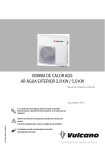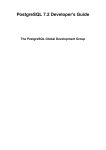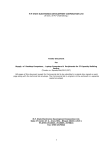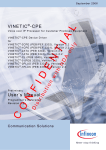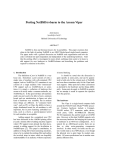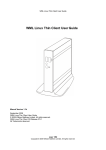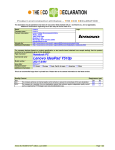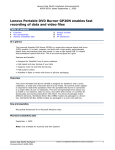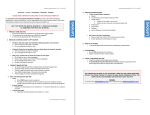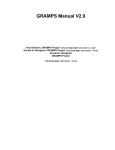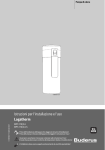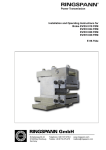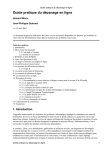Download WeTab Freedom Report
Transcript
AFULTab Contest WeTab Freedom Report 24/04/2012 DUEKIN CONSULTING Gubener Straße 40 10243 Berlin Germany AFUL 23 rue Greneta 75002 Paris France DUEKIN CONSULTING - WeTab Freedom Report Project: WeTab Freedom Report by Pierre Pronchery Copyright © 2012 DUEKIN CONSULTING This document is public and belongs to DUEKIN CONSULTING. This work is licensed under the Creative Commons Attribution-NonCommercial-ShareAlike 3.0 Unported License. To view a copy of this license, visit http://creativecommons.org/licenses/by-nc-sa/3.0/ or send a letter to Creative Commons, 444 Castro Street, Suite 900, Mountain View, California, 94041, USA.. Any error in this document is not intentional, please consult section 4, Errata for a list of known issues. More information on reporting issues, or obtaining an updated list of known errors can be found in the user manual in section 3.6, Finding and reporting issues. Revision history Version: 0.1 April 28, 2012 Reviewed by: PP April 30, 2012 Reviewed by: PP May 1, 2012 Reviewed by: PP Initial version delivered Version: 0.2 Minor formatting fixes Version: 0.3 Minor wording fixes Page 2 of 49 DUEKIN CONSULTING - WeTab Freedom Report Table of Contents 1. Project summary........................................................................................................................................................9 1.1 Overview............................................................................................................................................................9 1.2 Involved parties..................................................................................................................................................9 1.3 Project outcome................................................................................................................................................10 1.3.1 Contributions to the DeforaOS Project....................................................................................................10 1.3.2 Contributions to the NetBSD Project.......................................................................................................10 1.4 Perspectives......................................................................................................................................................10 2. Project execution......................................................................................................................................................11 2.1 Technical orientation........................................................................................................................................11 2.2 Foreseeable challenges......................................................................................................................................11 2.3 Development environment................................................................................................................................12 2.4 Tasks performed...............................................................................................................................................12 2.4.1 Defining the objectives............................................................................................................................12 2.4.2 Advocating the project.............................................................................................................................13 2.4.3 Becoming a NetBSD developer................................................................................................................14 2.4.4 Collecting the initial status.......................................................................................................................14 2.4.5 Unifying and debugging the existing interface.........................................................................................15 2.4.6 Implementing the touchscreen driver.......................................................................................................15 2.4.7 Integrating the DeforaOS distributed framework.....................................................................................16 2.4.8 Preparing for the release..........................................................................................................................17 3. Platform documentation..........................................................................................................................................18 3.1 How to read this documentation.......................................................................................................................18 3.1.1 Disclaimer................................................................................................................................................18 3.1.2 Conventions used.....................................................................................................................................18 3.2 Target hardware................................................................................................................................................18 3.2.1 WeTab GmbH Wetab...............................................................................................................................18 3.2.2 Lenovo IdeaPad S10-3t...........................................................................................................................19 3.3 Installation procedure.......................................................................................................................................19 3.3.1 Requirements...........................................................................................................................................19 3.3.2 Obtaining the sources..............................................................................................................................20 3.3.3 Building the base system..........................................................................................................................21 3.3.4 Building packages....................................................................................................................................21 3.3.5 Preparing the USB memory stick for installation.....................................................................................22 3.3.6 Installing the new system on the WeTab..................................................................................................22 3.4 Initial configuration..........................................................................................................................................23 3.4.1 Creating the default user..........................................................................................................................23 3.4.2 Installing the packages required...............................................................................................................23 3.4.3 Configuring the startup sequence.............................................................................................................24 3.4.4 Configuring the touchscreen....................................................................................................................25 3.4.5 Extra configuration..................................................................................................................................25 3.5 User manual.....................................................................................................................................................26 3.5.1 User interface...........................................................................................................................................26 3.5.2 Connecting to a Wireless network............................................................................................................28 3.5.3 Connecting to the 3G network.................................................................................................................28 3.6 Finding and reporting issues.............................................................................................................................29 3.6.1 How to report issues................................................................................................................................29 Page 3 of 49 DUEKIN CONSULTING - WeTab Freedom Report 3.6.2 For the DeforaOS Project........................................................................................................................29 3.6.3 For the NetBSD Project...........................................................................................................................30 4. Errata.......................................................................................................................................................................32 4.1 Known issues on the WeTab GmbH WeTab....................................................................................................32 4.1.1 The 3G modem is not supported.............................................................................................................32 4.1.2 Additional sensors are not supported.......................................................................................................32 4.1.3 The USB chipset may fail to initialize......................................................................................................33 4.2 Known issues on the Lenovo IdeaPad S10-3t..................................................................................................33 4.2.1 The 3G modem is not supported.............................................................................................................33 4.2.2 General system instability........................................................................................................................34 4.3 Known issues in DeforaOS..............................................................................................................................34 4.3.1 Mailer/#27: SMTP support......................................................................................................................34 4.3.2 Browser/#42: Copy & paste is not supported across browser windows...................................................35 4.3.3 Browser/#47: Drag & Drop support is not optimal..................................................................................35 4.3.4 Keyboard/#51: Support additional keyboard layouts...............................................................................36 4.3.5 Keyboard: Modifier keys are not properly tracked..................................................................................36 4.4 Known issues in NetBSD.................................................................................................................................37 4.4.1 kern/45853: Support for touchscreens in xf86-input-mouse....................................................................37 4.4.2 kern/45872: Issues and fixes for tpcalib (touchscreen calibration) ..........................................................37 4.4.3 kern/46189: wsfb/genfb red adn blue colours are reversed on bit depths 15 16 24 and 32 ....................38 4.4.4 Intel GMA graphics cards are not fully supported...................................................................................39 4.4.5 port-amd64/45197: failing to load secondary boot..................................................................................39 4.5 Other known issues..........................................................................................................................................40 4.5.1 Finger-scrolling is not supported..............................................................................................................40 4.5.2 Single-click activation is not supported....................................................................................................40 4.5.3 Third-button emulation is not supported..................................................................................................41 4.5.4 Additional languages are not supported...................................................................................................41 5. Appendix.................................................................................................................................................................43 5.1 Hardware specifications for the Lenovo IdeaPad S10-3t..................................................................................43 5.2 Hardware specifications for the WeTab GmbH WeTab....................................................................................43 5.3 Configuration files............................................................................................................................................44 5.3.1 /etc/mk.conf.............................................................................................................................................44 5.3.2 /usr/pkgsrc/pkgchk.conf...........................................................................................................................45 5.3.3 ~/.browser................................................................................................................................................47 5.3.4 ~/.desktoprc.............................................................................................................................................47 5.3.5 ~/.gtkrc-2.0..............................................................................................................................................47 5.3.6 ~/.locker...................................................................................................................................................47 5.3.7 ~/.mime...................................................................................................................................................48 5.3.8 ~/.panel....................................................................................................................................................49 5.3.9 ~/.phone...................................................................................................................................................49 Page 4 of 49 DUEKIN CONSULTING - WeTab Freedom Report List of tasks Title Reference Status Defining the objectives 2.4.1 Completed Advocating the project 2.4.2 Completed Becoming a NetBSD developer 2.4.3 Completed Collecting the initial status 2.4.4 Completed Unifying and debugging the existing interface 2.4.5 Ongoing Implementing the touchscreen driver 2.4.6 Ongoing Integrating the DeforaOS distributed framework 2.4.7 Cancelled Preparing for the release 2.4.8 Completed Page 5 of 49 DUEKIN CONSULTING - WeTab Freedom Report List of software installed This list is not exhaustive for practical reasons. Name Purpose Version License 6.0_BETA BSD or FOSS From the NetBSD Project, http://www.netbsd.org/ NetBSD Kernel, base system From pkgsrc (the NetBSD Packages Collection), http://pkgsrc.org/ and http://pkgsrc-wip.sourceforge.net/ bash Shell 4.2 GPL version 3 CUPS Printing service 1.5.0 GPL version 2 dhcpcd-gtk Networking 0.5.2 BSD dia Diagram editor 0.97.1 GPL version 2 Evince PDF viewer 2.32.0 GPL version 2 GDM Display manager 2.20.11 GPL version 2 GQview Image viewer 2.0.4 GPL version 2 Liferea RSS reader 1.4.28 GPL version 2 Matchbox-WM Window Manager 1.1 GPL version 2 Mozilla Firefox Web browser 8.0 MPL 1.1 Mozilla Thunderbird Mail client 8.0 MPL 1.1 MPlayer Media player SVN-r32219snapshot-4.5.3 GPL version 2 OpenOffice.org Productivity suite 3.1.1 GPL version 3 Pidgin Instant Messaging 2.10.0 GPL version 2 Sofia-SIP VoIP library (SIP) 1.12.11 LGPL version 2.1 Transmission Bittorrent client 2.42 GPL version 2, MIT TSClient Remote desktop 0.132 GPL version 2 xchat IRC client 2.8.8 GPL version 2 XTerm Terminal 259 MIT From the DeforaOS Project, http://www.defora.org/ Browser File manager 0.4.5 GPL version 3 Editor Text editor 0.2.0 GPL version 3 Keyboard Virtual keyboard 0.1.2 GPL version 3 Locker Screensaver 0.1.3 GPL version 3 Mailer Mail client 0.1.4 GPL version 3 Mixer Volume mixer 0.1.0 GPL version 3 Panel Desktop panel 0.2.12 GPL version 3 Page 6 of 49 DUEKIN CONSULTING - WeTab Freedom Report Name Purpose Version License PDFViewer PDF viewer 0.0.0 GPL version 3 Phone Telephony suite 0.3.9 GPL version 3 Player Media player 0.1.3 GPL version 3 Surfer Web browser 0.2.5 GPL version 3 Todo Task management 0.1.2 GPL version 3 Page 7 of 49 DUEKIN CONSULTING - WeTab Freedom Report List of known issues This table summarizes the issues listed in section 4, Errata. Platform Component Section Title WeTab Telephony 4.1.1 The 3G modem is not supported Hardware support 4.1.2 Additional sensors are not supported Boot 4.1.3 The USB chipset may fail to initialize IdeaPad S10-3t Telephony 4.2.1 The 3G modem is not supported Hardware support 4.2.2 General system instability DeforaOS Desktop 4.3.1 Mailer/#27: SMTP support Desktop 4.3.2 Browser/#42: Copy & paste is not supported across browser windows Desktop 4.3.3 Browser/#47: Drag & Drop support is not optimal Desktop 4.3.4 Keyboard/#51: Support additional keyboard layouts Desktop 4.3.5 Keyboard: Modifier keys are not properly tracked NetBSD Hardware support 4.4.1 kern/45853: Support for touchscreens in xf86-input-mouse Hardware support 4.4.2 kern/45872: Issues and fixes for tpcalib (touchscreen calibration) Polishing kern/46189: wsfb/genfb red adn blue colours are reversed on bit depths 15 16 24 and 32 4.4.3 Hardware support 4.4.4 Intel GMA graphics cards are not fully supported Boot 4.4.5 port-amd64/45197: failing to load secondary boot Other issues Desktop 4.5.1 Finger-scrolling is not supported Desktop 4.5.2 Single-click activation is not supported Desktop 4.5.3 Third-button emulation is not supported Desktop 4.5.4 Additional languages are not supported Page 8 of 49 DUEKIN CONSULTING - WeTab Freedom Report 1. Project summary 1.1 Overview The AFUL is a non-profit association based in France, whose aim is to promote general use of Free and Open Source Software (FOSS) as well as Open Standards. It has an international reach, particularly among Frenchspeaking countries around the world. As part of this mission statement, the AFUL has organized an international competition called “AFULTab”, calling for Open Source developers to compete and offer a fully functional Tablet device in a finite amount of time. It is intended for both professional and private users, by the exclusive means of software and applications under a free software license. This competition was announced in November 2011, with a deadline for the final submission on May 1st, 2012. DUEKIN CONSULTING is the freelance activity of Pierre Pronchery, a Freelance IT-Security Consultant and Open Source developer based in Berlin, Germany. DUEKIN CONSULTING entered this competition, choosing the WeTab tablet from WeTab GmbH as target hardware. An additional tablet hardware was also used while implementing this project, the IdeaPad S10-3t from Lenovo. Besides fulfilling the requirements of the competition, by installing and documenting a FOSS Operating System on this hardware, the initial aim was to develop a proof-of-concept (PoC) deployment of the most advanced technologies part of the DeforaOS Project. The aim of the DeforaOS project is to allow remote and secure access to user applications and data. This approach is based on a cross-platform distributed computing framework, which can installed and used on current Operating Systems. Even though existing applications can benefit directly from the framework, the project supplies its own desktop environment and user interface. It also supports embedded, touch-based platforms, with a finger-friendly version of the interface. In this competition, the tablet was developed on top of the NetBSD Operating System. The NetBSD project is similar to a GNU/Linux distribution, however based on the historical 4.4BSD family of UNIX systems from the University of California in Berkeley, USA. Its license terms, also known as the BSD license, are compatible with those of the newer FOSS licenses such as the GPL, and therefore suitable for this project. 1.2 Involved parties For AFUL: Laurent Séguin President e-mail: [email protected] Web: http://aful.org/ For DUEKIN CONSULTING: Pierre Pronchery Freelance Open Source Developer e-mail: [email protected] Mobile: +49 (0)177 472 7481 Web: http://www.duekin.com/ Page 9 of 49 DUEKIN CONSULTING - WeTab Freedom Report 1.3 Project outcome Most importantly, the deployment of a functional end-user environment on the tablet, based on the DeforaOS User Interface and NetBSD Operating System was successful. A number of achievements were completed during the course of this project, and believed to be beneficial to both the NetBSD and DeforaOS projects. A number of new components, fixes, or general improvements as either software or documentation were submitted to both projects, with most already integrated while writing this report. It was also a very positive experience on a personal level, with the developer of this project, Pierre Pronchery, being invited and accepted as an official NetBSD developer before the final submission. This was both the result and additional motivation for contributions and learning more about end-user and system development in Open Source Operating Systems. Unfortunately, some parts of the initial proposal could not be fully completed, are known to have problems, or are still completely missing from the current deployment. They are listed in section 4, Errata in this document. 1.3.1 Contributions to the DeforaOS Project The DeforaOS has already benefitted to a major extent from this project: the desktop environment could be further tested, fixed and improved, with a number of new software releases hitting the website. It has certainly also gained in visibility and definitely in its documentation, which should be merged online with the contents of this document. A complete rewrite of the website was also initiated during this project, although not detailed in this report; while not being ready at this time, it should also help the project be more attractive. (The DeforaOS logo is under Copyright to The DeforaOS Project) 1.3.2 Contributions to the NetBSD Project Likewise, it is also believed that the NetBSD project has gained from this initiative. While not being easy to measure, it has apparently welcome this effort by inviting and accepting its developer into the NetBSD Foundation, the parent organization to the project. This certainly means that the contributions were valuable, and a trust relation built while submitting issues and patches. (The NetBSD logo is under Copyright to The NetBSD Foundation) 1.4 Perspectives While still far from being perfect, the environment is already fully functional. Once the remaining hardware issues solved, it can be further leveraged for everyday use in terms of usability and power management in particular. More interestingly, it proved an excellent and practical test platform for the DeforaOS desktop environment. As such, it will be very helpful when actually implementing the distributed framework as part of the user interface. Page 10 of 49 DUEKIN CONSULTING - WeTab Freedom Report 2. Project execution 2.1 Technical orientation The hardware platform chosen for this project is the WeTab from WeTab GmbH. Although based on commodity hardware (Intel-compatible) and not really proprietary, this platform is not fully standard (dedicated firmware). The target Operating System for the project was NetBSD, which was not known to have support for tablet devices thus far (with the exception of the Sharp Zaurus). The user interface chosen was based on a smaller project, DeforaOS, also mainly developed by the author of this project and report. The target audience was intended to be for both casual and business use, through the integration of DeforaOS' advanced distributed framework within the user interface. The WeTab tablet (from “Serv” via Wikipedia, http://en.wikipedia.org/wiki/File:WeTab.png) Therefore, the major achievement in this project was expected to be on the software side, both for the NetBSD Operating System (hardware support, desktop integration) and for the DeforaOS desktop environment (tablet interface, polishing, extending). 2.2 Foreseeable challenges The first uncertainty was to be able to install and boot NetBSD on the target hardware. Although based on a common Intel architecture and chipset (found in many netbooks), support for this chipset was already known to be incomplete within NetBSD (for the graphics subsystem in particular). Additionally, the target hardware was known to have a specific firmware when booting, which could mean modifications to the NetBSD bootloader. Then, hardware parts specific to tablets were not believed to be well supported so far within NetBSD, of which the touchscreen in particular. A Google Summer of Code (GSoC) project called “Expansion for wstablet in NetBSD ” was completed in 2008, but without particular support for user interaction on tablets included so far (see http://netbsd-soc.sourceforge.net/projects/wscons/). Finally, the third challenge was to adapt and raise the quality of the existing DeforaOS applications to a fully functional environment, when installed and configured to run on a tablet device. Hopefully, the additional innovative features planned could be developed and included as well, but only as far as the timeframe would allow it. Page 11 of 49 DUEKIN CONSULTING - WeTab Freedom Report 2.3 Development environment Hardware components Most of the development effort was conducted on two systems alternatively, a Sun Ultra 24 workstation and a Lenovo ThinkPad T60 (2007) laptop respectively. They were both running NetBSD for Intel-compatible 64-bits computers (amd64), and upgraded to the 6.0_BETA version as soon as it was available. While waiting for the final tablet hardware to be available and delivered, tests were conducted on a Lenovo IdeaPad S10-3t netbook. It offered very similar hardware to the WeTab, including a tablet mode (rotating screen and touchscreen). More details about this tablet hardware can be found in 3.2.2, Lenovo IdeaPad S10-3t. Testing on the final tablet hardware, the WeTab, could only begin in early March 2012. More details about this tablet can be found in 3.2.1, WeTab GmbH Wetab. Software platforms used As mentioned above, NetBSD was used for development, along with packages from pkgsrc's pkgsrc-2011Q4 release (custom built). The desktop environment used was from DeforaOS, like that used on the tablet (except not in embedded mode). All of the tools required were part of either of these two platforms, and distributed under a FOSS-compliant software license. Specific tools A few tools were useful in particular, of which: • GCC, the GNU Compiler Collection, http://gcc.gnu.org/ • DeforaOS configure, a Makefile generator, http://www.defora.org/os/project/16/configure • make, as provided byNetBSD, http://www.netbsd.org/ • vim, a vi clone improved, http://www.vim.org/ • CVS, Concurrent Versions System, http://savannah.nongnu.org/projects/cvs • Xephyr, a KDrive-based X server, http://www.freedesktop.org/wiki/Software/Xephyr • Apache OpenOffice, the Free and Open productivity suite, http://www.openoffice.org/ Additional resources DeforaOS is hosted on both personal infrastructure and a virtualized hosting server, provided by DUEKIN CONSULTING. 2.4 Tasks performed 2.4.1 Defining the objectives Description Before anything, a list of functionalities essential to regular operation of the device was compiled. Page 12 of 49 DUEKIN CONSULTING - WeTab Freedom Report The list was defined as follows, in decreasing priority: 1. File management (drag & drop, MIME interaction) 2. Web surfing (tab browsing, finger-based interaction...) 3. Proper handling of e-mail (IMAP, SSL...) 4. Media player (codec support...) 5. Rest of the desktop environment (panel, screensaver, office applications...) 6. Bootup time 7. Documentation covering all essential aspects (installation, user manual) 8. Connectivity to wireless networks 9. Hardware support in general 10. Integration of the DeforaOS experimental distributed framework Challenges This list is long and ambitious for a single developer in spare time. In practice, the development effort was focused on whichever area felt the most lacking at a given time. Outcome The tablet was delivered in a functional state, although most areas could not be completed as good as desired. Integration of the DeforaOS distributed framework in particular could not be performed at all. 2.4.2 Advocating the project Description Communicating about the project was done regularly. The primary reason was to look for direct support (testers, developers), although raising awareness about the technologies used is also welcome and important. Means used for this task were social networking websites like Tweeter (through the @DeforaOS account, with hashes #AFULTab, #DeforaOS and #NetBSD), or freecode for software releases in particular (formerly known as freshmeat). Both DeforaOS and NetBSD projects can also be found on Ohloh (http://www.ohloh.net/) and CIA (http://cia.vc/), two popular software repository directories. Additionally, a talk was held at the FOSDEM Open Source conference in Brussels, on February 5th. It took place at the BSD Devroom. Challenges NetBSD is not the most popular Open Source Operating System around, and not the most popular BSD-based one either. As such, it does not have as much visibility as GNU/Linux for instance. Likewise, DeforaOS is the effort of a single developer for the most part, and its current popularity reflects this status. There was little Page 13 of 49 DUEKIN CONSULTING - WeTab Freedom Report feedback so far on the ideas and concepts proposed as part of the project. Outcome Reception of the talk given at FOSDEM was very positive. It eventually created a new but welcome task, being invited and then joining the NetBSD project as an official developer. This task is detailed below as 2.4.3, Becoming a NetBSD developer. 2.4.3 Becoming a NetBSD developer Description This task was not planned initially, but was a most welcome consequence of the project advocacy from task 2.4.2, Advocating the project. It allowed contributions to the NetBSD Project to be integrated faster, thanks to a direct access to the source tree, to the issue tracker as well as to internal discussions about specific issues. Moreover, prior submission of a number of issues (often including fixes) as well as regular presence at conferences and development events involving members of the NetBSD Foundation before this project certainly also helped for this task to happen in the first place. Challenges Although not as thorough and heavy process as some other popular Open Source Operating System projects, the integration process does not happen overnight, and requires meeting at least one active NetBSD developer in person. This was difficult given the traveling obligations of Pierre Pronchery in the second half of the project, but could nonetheless be planned a few weeks after submitting the application form. Another minor glitch was with the request for the last administrative details, which e-mail was delayed by another couple weeks before reaching its destination. Outcome As of April 16th 2012, Pierre Pronchery was officially accepted as a NetBSD developer. He could append his name to the source tree and main website himself the following day. He could also submit his first contributions as a developer after a week, with more awaiting integration. Most should be available in the upcoming release, NetBSD 6.0. 2.4.4 Collecting the initial status Description Once the objectives defined, a test system with the current state of the kernel, base system and desktop applications was installed and configured. This was a more practical approach to the project planning and management, and very likely to be more realistic and accurate for the development of a usable platform. At this point, an initial list of known issues could be compiled, published and worked incrementally upon. This was to be done according to their respective priorities. Page 14 of 49 DUEKIN CONSULTING - WeTab Freedom Report Challenges At this point, the final hardware was not available for tests. It was therefore chosen to use another tablet hardware, but more suitable for development. The Lenovo IdeaPad S10-3t was chosen for its apparent similarity with the WeTab. This system is therefore also described in this document, as it had an important role in the development process. As was quite expected, the list of places to improve, work on or even fully implement was certainly longer than time would allow. Outcome The initial priorities had to be re-evaluated, with a list of the most important ones maintained online at http://www.defora.org/os/wiki/3622/AFULTab-contest. Where applicable, bug reports were issued upstream, and their status also tracked on this page. The most important change in priorities was with hardware support, which became the highest priority: support for the touchscreen was required before anything else. Then, the main focus was on bugfixing and improving the DeforaOS desktop, while advocating the project as opportunities occurred. 2.4.5 Unifying and debugging the existing interface Description The development sources of the DeforaOS desktop were generally more advanced than the code released thus far. They included a number of new features, often required or desirable for proper tablet-based interaction, but unfortunately incomplete or not fully functional in some cases. These changes required further testing, completion and proper releases and packaging. Challenges There was no particular challenge associated with this task, as this operation benefitted directly from the experience gathered when working on the DeforaOS smartphone interface for the hackable:1 project (see http://trac.hackable1.org/trac/wiki/DeforaOSSmartphone). It was actually easier, as testing could occur within a native environment, without required cross-compilation or hardware emulation. Xephyr was particularly useful while performing this task. Outcome Most projects part of the DeforaOS desktop environment were released at least once while performing this task. 2.4.6 Implementing the touchscreen driver Description Two existing drivers for touchscreen were found to be available within the NetBSD project: uep(4) and zts(4). Gathering information about the touchscreen panel found on the Lenovo IdeaPad S10-3t, it was determined that it is a USB HID device, not unlike most modern multi-touch panels. Very useful information could be obtained Page 15 of 49 DUEKIN CONSULTING - WeTab Freedom Report from Microsoft, as linked here: http://msdn.microsoft.com/en-us/windows/hardware/gg487437 . Although useful as a reference implementation, neither of the existing touchscreen drivers in NetBSD supported this kind of touchscreen. However, the ums(4) driver (for USB mice) was very useful when interacting with the USB HID bus on NetBSD. Challenges Writing a kernel driver is rarely a trivial task. It can be a time-consuming and frustrating experience, as proper testing often requires complete reboots with little more information than “it does not work”. In this case, it also required transferring the test kernel over a USB memory stick, or alternatively setting up a remote boot infrastructure. The availability of a hardware platform supporting the same driver for the touchscreen chipset was of great help (the Lenovo IdeaPad S10-3t). With its built-in keyboard and touchpad, it was much easier to successfully debug and integrate the driver within the existing infrastructure. Getting the driver to work on the Lenovo netbook was not sufficient though. In practice, the chipset found in the WeTab required additional parameters in order to work correctly. Because of their particular form-factor, Microsoft recommended touchscreen chipset makers to pre-configure their firmwares in “mouse mode” for tablets, where they would allow Operating Systems to function without dedicated support for instance. The resulting behavior was wrongly interpreted as incorrect screen calibration, whereas the real solution was to force the chipset to “multi-input” mode. Outcome The uts(4) driver was submitted for inclusion on January 17th, and imported to the NetBSD tree shortly after. It is already part of the initial NetBSD 6.0_BETA release. The steps providing additional support for Xorg were submitted as separate Problem Reports, and available in the base system as well as within pkgsrc. Its addition seems to have been well received, and has certainly helped the process of becoming an official developer. 2.4.7 Integrating the DeforaOS distributed framework Description The DeforaOS Project is not only about providing a desktop environment, but primarily about enabling applications to access user data remotely yet securely. This is even possible when the data is only found on a workstation behind a firewall, and accessed from a tablet computer on a separate network. A working prototype is already available, where a video file can be played remotely and efficiently over a TCP connection (optionally secured with SSL), without requiring any change to the media player. Challenges The current codebase already required a major rewrite when beginning the project. This is for a number of reasons: • Proof-of-Concept (PoC) code only used for prototypes thus far • as a result, hard-coded implementation of a single underlying protocol Page 16 of 49 DUEKIN CONSULTING - WeTab Freedom Report • most importantly, no easy possibility of integration with the event-driven programming library underlying Gtk+ (the graphical toolkit used in the DeforaOS desktop environment) Unfortunately these issues could not be tackled early enough to be integrated into the project. Outcome This task had to be cancelled. 2.4.8 Preparing for the release Description The deadline for this project was on May 1 st 2012. This applied for the hardware and the documentation accompanying it, which both had to be delivered in Paris before this date. Challenges Polishing is a neverending task, where invariably new bugs or problems are discovered. A tradeoff had to be made between a satisfying, functional result and delivering in time. This was considered to be fine, as long as the remaining issues were documented accordingly. Outcome Software releases were issued for the relevant projects, with their respective packages updated in the pkgsrc-wip repository. The elaboration of this report was another direct outcome of this task, with the tablet scheduled to be delivered on time on April 30th. Page 17 of 49 DUEKIN CONSULTING - WeTab Freedom Report 3. Platform documentation 3.1 How to read this documentation 3.1.1 Disclaimer This section was originally published as part of the final submission for the AFULTab project, with the intention to be redistributable as a separate document. It summarizes the steps required for the preparation, installation, configuration and final use of a tablet device such as the WeTab, together with a user environment based on the NetBSD Operating System and DeforaOS desktop environment. The reader of these instructions is assumed to have a working knowledge of UNIX systems, and to be familiar with the manual installation procedures for such systems. The instructions and commands mentioned in this documentation are given to the best of the writers' knowledge, under time constraints. They should be carefully reviewed before used, and adapted as necessary. They may be subject to changes, as either of the underlying platforms may be evolving as well. Therefore, no damage may be claimed as a result of applying these instructions. 3.1.2 Conventions used The commands listed in this document are typically preceded by the “#” or the “$” sign, representing the shell prompt for an administrator and a regular user respectively. They should therefore be entered with the relevant privileges, which availability should be ensured beforehand. For clarity, a standard procedure has been included in some cases; it may be replaced with a different procedure if so desired or necessary. Commands, system components or drivers for which a manual page is available on a NetBSD system are followed with the corresponding manual section enclosed within parenthesis. For instance, “ls(1)” means that the command “ls” is documented by a manual page, in section 1. This page can be obtained as follows: $ man 1 ls In this example, it is therefore meant to enter “man 1 ls” directly within a shell, and that this command should work as an unprivileged user. 3.2 Target hardware 3.2.1 WeTab GmbH Wetab Hardware specifications The WeTab is an Intel-based 64-bits tablet computer, using an Atom N450 processor clocked at 1.66 GHz. The processor is completed by 1 GB of RAM, along with 32 GB flash memory (for local storage). This capacity can be extended through the SD card slot (up to another 32 GB memory with SDHC cards). The screen is a 11.6” widescreen (16:9) with a resolution of 1366x768 pixels, and supports multi-touch input. Battery life is estimated at 6 hours (according to the vendor). Besides the headphones output, the tablet offers 2 standard USB 2.0 ports, and a mini-HDMI video output. Finally, wireless connectivity includes 802.11bgn, Bluetooth 2.1 and 3G as Page 18 of 49 DUEKIN CONSULTING - WeTab Freedom Report well. The complete specifications can be found in 5.2, Hardware specifications for the WeTab GmbH WeTab. Software support The WeTab is delivered pre-installed with a custom Linux distribution called WeTab OS, based on the former Meego platform. Replacing this system with a fully FOSS software platform is detailed in 3.3, Installation procedure. Please refer to the Errata section 4.1, Known issues on the WeTab GmbH WeTab for a list of known issues. 3.2.2 Lenovo IdeaPad S10-3t Hardware specifications The IdeaPad S10-3t from Lenovo is a netbook, equipped with a rotating screen with multi-touch support. Like the WeTab, it is based around an Atom N450 CPU clocked at 1.66 GHz, but more extensible with up to 2 GB of RAM. The screen size differs from the WeTab, with a 10” screen offering a resolution of 1024x600 pixels, also supporting multi-touch input. The rest of the specifications can be compared with the WeTab, including 802.11bgn, Bluetooth and 3G networking, MicroSD slot, USB and VGA ports, although with a hard disk drive (up to 320 GB) and a full laptop keyboard of course. The complete specifications can be found in 5.1, Hardware specifications for the Lenovo IdeaPad S10-3t. Software support The IdeaPad is typically delivered with a Windows 7 system. Just like any regular Personal Computer, it is easily replaced with a FOSS Operating System. The installation procedure of the WeTab can however be followed, from which a few steps can simply be omitted. A list of known issues on this system was elaborated as well, and is found in 4.2, Known issues on the Lenovo IdeaPad S10-3t in this report. 3.3 Installation procedure 3.3.1 Requirements This guide assumes the availability of a 6.0_BETA NetBSD system (or newer 6.0 release). An Intel-compatible 64-bits platform is recommended and referred to here; this port of NetBSD is called “amd64”. Documentation to obtain, install and configure this system can be found in the NetBSD Guide, which is available online at http://netbsd.org/docs/guide/en/. Be sure to install the “comp” set A complete repartitioning and formatting of the main hard disk drive may be required, therefore its initial contents should be backupped before anything, as they may be lost or damaged during this operation. Page 19 of 49 DUEKIN CONSULTING - WeTab Freedom Report The NetBSD Guide as found online Once a NetBSD system installed, it is also recommended to have at least 20 GB of free storage space before beginning this procedure. A single USB memory stick will be used to transfer and install the new system on the tablet, which should however offer at least 2 GB of storage. Likewise, a complete repartitioning and formatting of the USB stick may be required; make sure to backup its contents if necessary before proceeding. Additionally, a USB keyboard will be required while installing and configuring the tablet, before it can be fully used with finger-based interaction. 3.3.2 Obtaining the sources Although also likely with the binary sets and packages available online, the installation will be performed from the source files. They can be obtained as follows, assuming the regular user is in the “wsrc” group: $ su Password: # mkdir -p -m 775 /usr/src /usr/pkgsrc # chgrp wsrc /usr/src /usr/pkgsrc # logout $ cd /usr $ cvs -d:ext:[email protected]:/cvsroot co -r netbsd-6 src [...] $ cvs -d:ext:[email protected]:/cvsroot co -r pkgsrc-2011Q4 pkgsrc [...] $ cd /usr/pkgsrc $ touch ~/.cvspass $ cvs -d:pserver:[email protected]:/cvsroot/pkgsrc-wip co wip [...] At this point, the sources for the entire NetBSD base system (6.0 branch), the pkgsrc Packages Collection Page 20 of 49 DUEKIN CONSULTING - WeTab Freedom Report (pkgsrc-2011Q4 release) and its staging repository should be present on the local system. 3.3.3 Building the base system First, the system and installation kernels and sets have to be compiled. It can be done as follows: $ su Password: # mkdir -p -m 775 /usr/obj /usr/tools # chgrp wsrc /usr/obj /usr/tools # logout $ cd /usr/src $ ./build.sh -O /usr/obj -T /usr/tools releasekernel=GENERIC \ releasekernel=INSTALL distribution sets [...] The resulting binary kernels and sets should then be available in the /usr/obj/releasedir/amd64/binary/kernel and /usr/obj/releasedir/amd64/binary/sets folders, respectively. At this point though, the netbsd-INSTALL.gz kernel cannot be used to install the system, as it does not contain the installation ramdisk; to create it, proceed as follows: # cd /usr/src/distrib/amd64/instkernel # /usr/tools/bin/nbmake-amd64 The resulting kernel should then embed the ramdisk, and be found in /usr/obj/distrib/amd64/instkernel/netbsd-INSTALL.gz. 3.3.4 Building packages A number of different tools are available to build and install packages, such as pkgin(1), which resembles Debian's apt subsystem. However, here, the use of pkg_chk(8) was prefered, as it allows compiling and deploying the packages required directly. This allowed more control over the compilation options and eventual patches required. The /etc/mk.conf file contains these options, of which a copy can be found in 5.3.1, /etc/mk.conf. As for pkg_chk(8), it uses the file /usr/pkgsrc/pkgchk.conf by default, of which a copy is also found in 5.3.2, /usr/pkgsrc/pkgchk.conf. This assumes that no package is currently installed on the system; to reset the system to this state, simply enter the following command as the root user: # pkg_delete '*' First, install the pkg_chk package, as follows: # cd /usr/pkgsrc/pkgtools/pkg_chk # make install clean With this done, build and create all the packages required through pkg_chk(8) this way: # pkg_chk -askD wetab The resulting packages should be available in the /usr/pkgsrc/packages folder. Page 21 of 49 DUEKIN CONSULTING - WeTab Freedom Report 3.3.5 Preparing the USB memory stick for installation For simplicity, the filesystem used on the USB stick will be a 32-bits MS-DOS FAT. The first thing to identify, is how the stick is partitioned and detected by the system. One way to identify it is to read the output of the dmesg(8) command after inserting the stick; the corresponding device node is usually sd0e, which will be assumed here. Be however very careful to be using the proper device. Re-partitioning can be done with the fdisk(8) command, which features an interactive mode. Proper detection by the system can be verified (or updated) with the disklabel(8) command. A FAT filesystem can then be created on a given partition as follows: # newfs_msdos -F 32 sd0e Mounting and accessing this filesystem can then be performed as described here: # mkdir -p /mnt/usb # mount /dev/sd0e /mnt/usb To prepare the stick for installation, while it is mounted: # cp /usr/mdec/boot /mnt/usb/boot # installboot /dev/rsd0e /usr/mdec/bootxx_msdos # cat > /mnt/usb/boot.cfg << EOF banner=Welcome to the DeforaOS installer banner================================== banner= banner=Please choose an option from the following menu: menu=NetBSD/amd64 install:boot release/amd64/binary/kernel/netbsd-INSTALL.gz menu=Drop to boot prompt:prompt default=1 timeout=10 EOF # mkdir -p /mnt/usb/release # cp /usr/obj/distrib/amd64/instkernel/netbsd-INSTALL.gz /mnt/usb/release # cp -R /usr/obj/releasedir/amd64 /mnt/usb/release # mkdir -p /mnt/usb/packages/amd64 # cp -R /usr/pkgsrc/packages/amd64/All /mnt/usb/packages/amd64 # cp /usr/pkgsrc/pkgchk.conf /mnt/usb/packages Before the last step, be sure to unmount the stick before removal: # umount /mnt/usb This last operation is required by the firmware on the WeTab, to actually recognize the USB stick as being an authorized boot device: # printf '\x9d\x2a\x44\x7b' | dd of=/dev/sd0d oseek=440 bs=1 count=4 3.3.6 Installing the new system on the WeTab Before trying to boot the USB stick on the WeTab, it is recommended that its battery is fully charged, and the tablet connected to the power supply. With the device turned off, insert the USB stick into either of the USB ports, and press the power button briefly. Then, as soon as the blue LED turns on, press again briefly on the power button while holding the tablet over the “soft button”. The “soft button” is a sensor located at the top left of the tablet, left from the LED indicators. The system will then boot the installer after a few seconds. At this point, the generic installation instructions can be followed: Page 22 of 49 DUEKIN CONSULTING - WeTab Freedom Report • it is easier to use the whole disk, and leave the disk geometry as detected; • it is recommended to create a single “a” partition for the root filesystem (entering “+” for its size), with 1 GB of flash and a 256 MB memory filesystem “mfs” for /tmp; • a “Custom” installation should be chosen, and the “kern-GENERIC.tgz” set disabled from the list; • the sets are to be found from the USB stick, which is an “Unmounted filesystem”, on the “sd0e” device, with an “msdos” filesystem (the other fields can be left unchanged) At the end of the installation process, it is likely that the sanity check for the new installation will fail: it is missing a kernel to boot from. It has be installed from the utility menu, from the command line interface: # # # # # mkdir -p /target /usb mount /dev/sd0e /usb mount /dev/wd0a /target cp /usb/release/amd64/binary/kernel/netbsd-GENERIC.gz /usb/netbsd umount /target /usb At this point, the tablet should be in a bootable state. It can be rebooted, and will be easier to configure after the first boot. 3.4 Initial configuration 3.4.1 Creating the default user As recommended by the system after the first login as the “root” superuser, a regular user account has to be created. It is recommended to create it this way, assuming “afultab” is the username chosen: # mkdir -p /home/afultab # groupadd -g 1000 afultab # useradd -g afultab -u 1000 -G wheel,operator -d /home/afultab \ -s /bin/ksh afultab # chmod 700 /home/afultab # chown afultab:afultab /home/afultab The default shell for the user could be later changed for bash, which some might consider more practical. Once its package installed, the following command would select it by default: # usermod -s /usr/pkg/bin/bash afultab 3.4.2 Installing the packages required For this step the USB memory stick used during the installation procedure has to be mounted again. A default mountpoint for the memory stick can be created as follows: # mkdir -p /mnt/usb # cat >> /etc/fstab << EOF /dev/sd0e /mnt/usb msdos rw,noauto,nosync,-u=1000,-g=1000,-M=0700,-m=0600 EOF The packages required can then be installed automatically as follows: # mount /mnt/usb # cd /mnt/usb/packages # pkg_add pkg_chk-2.0nb1.tgz Page 23 of 49 DUEKIN CONSULTING - WeTab Freedom Report # pkg_chk -abP “$PWD” -D wetab [...] # cp /usr/pkg/share/examples/rc.d/* /etc/rc.d/ At this point all of the packages required should be installed. Their initialization scripts should also be available to the base system, and will require proper configuration for the startup sequence. 3.4.3 Configuring the startup sequence On NetBSD systems a single file controls most of the bootup sequence: /etc/rc.conf. This file should typically be extended with the following contents: hostname=wetab.afultab dhcpcd=YES mixerctl=YES mixerctl_mixers=”mixer0” wpa_supplicant=YES wpa_supplicant_flags=”-B -iath0 -c/etc/wpa_supplicant.conf” avahidaemon=NO cupsd=NO dbus=NO estd=YES famd=NO hal=NO gdm=YES slpd=NO Of course the hostname can be set to another value as desired. Then, it may make sense to configure the X and gdm display servers already. It can be performed as follows: # # # # # cd /root X -configure mkdir -p /usr/pkg/etc/X11 mv /root/xorg.conf.new /usr/pkg/etc/X11/xorg.conf /etc/rc.d/gdm start Note that it may be required to set the default depth for Xorg to 24, and to force the mouse device to “/dev/wsmouse2” instead of the default “/dev/wsmouse”. At this point it is recommended to enable automatic login for the “afultab” user via the configuration interface from gdm. The keyboard sequence Ctrl+Alt+F1 to F5 can be used to switch back to virtual consoles; the fifth is where X should be found by default. The user session has to be defined next; it can be done as the “afultab” user: # su – afultab $ cat > .Xclients << EOF #!/bin/sh /usr/local/sbin/wscalib desktop & dhcpcd-gtk & locker & panel & phone & matchbox-window-manager -use_titlebar no -use_cursor no -use_desktop_mode plain EOF $ chmod 700 .Xclients With this done, the tablet should already boot to a usable interface. Finally, the bootloader can be re-configured to display a splash picture while booting. It is recommended to Page 24 of 49 DUEKIN CONSULTING - WeTab Freedom Report enable this feature only once the system is known to boot properly. A splash picture also has to be copied on the filesystem; JPEG files are supported, although without progressive encoding. Assuming the /deforaos.jpeg file is to be used as the splash screen, the contents of the /boot.cfg file can be modified as follows: banner=Welcome to NetBSD banner================== banner= banner=Please choose an option from the following menu: menu=Boot normally:vesa 800x600x16;splash /deforaos.jpeg;boot /netbsd.gz -z menu=Boot normally (text mode):boot /netbsd.gz menu=Boot single user:boot /netbsd.gz -s menu=Disable ACPI:boot /netbsd.gz -2 menu=Disable ACPI and SMP:boot /netbsd.gz -12 menu=Drop to boot prompt:prompt default=1 timeout=5 Also ensure that the /netbsd.gz kernel is installed as expected. As keyboards are not supported during the boot sequence, this menu is hardly required for proper operation, and the timeout can even be reduced to 0 for instant boot. 3.4.4 Configuring the touchscreen The screen is to be calibrated at every startup by the end-user: # mkdir -p /usr/local/sbin # cat > /usr/local/sbin/wscalib << EOF #!/bin/sh /sbin/wsconsctl -f /dev/wsmouse2 -w calibration.samples=0,0,0,0:32767,32767,1023,767:32,0,1,0:0,43,0,1 EOF # chmod 770 /dev/wsmouse2 While its driver is incomplete, the touchscreen also has to be switched to multi-input mode at every startup: # cat >> /etc/rc.local << EOF /usr/bin/usbhidctl -f /dev/uhid1 -w 0x000e.Finger.Input_Mode=2 EOF This latter command may require an updated version of the /usr/share/misc/usb_hid_usages file, with the “Input Mode” HID usage defined accordingly within the “Digitizer” section. 3.4.5 Extra configuration Some additional steps for proper integration are included here. They are by no means complete, and improvements are always likely, although often subjective at some point. For integration between the WPA sub-system and the desktop: # cat > /etc/wpa_supplicant.conf << EOF ctrl_interface=/var/run/wpa_supplicant ctrl_interface_group=wheel update_config=1 EOF For system-wide telephony support: # chmod 770 /dev/ttyU0 Page 25 of 49 DUEKIN CONSULTING - WeTab Freedom Report # mkdir -p /etc/ppp/peers # touch /etc/ppp/options # cat > /etc/ppp/ip-up << EOF #!/bin/sh cp /etc/ppp/resolv.conf /etc/resolv.conf EOF # chmod 700 /etc/ppp/ip-up # cat > /etc/ppp/peers/phone << EOF notty defaultroute local noauth usepeerdns mru 296 mtu 296 EOF For the desktop environment, a number of sample files to be placed in the user's home directory have been included in the Appendix of this document: • ~/.browser • ~/.desktoprc • ~/.gtkrc-2.0 • ~/.locker • ~/.mime • ~/.panel • ~/.phone Most of the desktop applications can otherwise be configured via their respective user interfaces. 3.5 User manual 3.5.1 User interface The user interface is organized as follows by default: Page 26 of 49 DUEKIN CONSULTING - WeTab Freedom Report 1. The top left indicator tracks the current mobile operator 2. The top right indicator track the CPU frequency, battery and volume information, followed by the notification area (systray), clock and a close button 3. The middle of the screen is the main area, where the current application is running (in fullscreen mode by default) 4. The bottom left button is the main menu, followed by the virtual keyboard switch and the task list (sorted by most recently used) Here is an example of text input, from within the text editor, with the virtual keyboard activated: Page 27 of 49 DUEKIN CONSULTING - WeTab Freedom Report 3.5.2 Connecting to a Wireless network Connecting to a wireless network can be performed via the notification area, with a single click on the network icon; the different networks available are then listed, with a prompt for the WPA passphrase if required: 3.5.3 Connecting to the 3G network Connecting to the Internet over the mobile network is performed similarly, using the globe icon instead. The connection window contains two tabs (settings and connection status). A sample configuration screen is as follows: The status screen can then be used to connect and disconnect to and from the network, as well as to monitor connectivity. Page 28 of 49 DUEKIN CONSULTING - WeTab Freedom Report 3.6 Finding and reporting issues 3.6.1 How to report issues The first thing to do when finding an issue, is to try to identify in which component it belongs: • the DeforaOS desktop environment, or any end-user applications part of it • the NetBSD Operating System, including the kernel or the base system • a third-party application, provided by a package from the pkgsrc Packages Collection The latter two are handled together by the NetBSD Project, for which instructions are found below in 3.6.3, For the NetBSD Project. If in doubt, the issue tracking system from the DeforaOS Project can be used, as detailed in 3.6.2, For the DeforaOS Project. A list of known issues at the time of this report can be found in section 4, Errata, and is also summarized in a table at the beginning of this document. For practical reasons, this list is not exhaustive and only contains the most significant issues. 3.6.2 For the DeforaOS Project The issue tracker for the DeforaOS Project can be found online at the following address: https://www.defora.org/os/project/bug_list (also works without SSL). Issues are tied to the particular sub-project they belong to, or to the global “DeforaOS” project in any other case. New issues can be filed at https://www.defora.org/os/project/bug_new; a user account is currently necessary. It is possible to register at https://www.defora.org/os/user/register. Even though a complete rewrite of the website is currently in progress, the reporting procedure is expected to remain the same. Page 29 of 49 DUEKIN CONSULTING - WeTab Freedom Report The newer interface on defora.org to list and report bugs 3.6.3 For the NetBSD Project Likewise, NetBSD offers a public issue tracker online, where existing issues can be listed through a search engine at http://www.netbsd.org/support/query-pr.html. There are mainly two ways to report new issues: • with the “send-pr” utility on any NetBSD system (requires a functional local mailer) • by filling in a form online, at http://www.netbsd.org/cgi-bin/sendpr.cgi?gndb=netbsd Issues for the kernel, base system and packages from pkgsrc are all listed in the same place, with issues bound to the relevant category: it can be “kern” for the kernel, “pkg” for packages for instance. Page 30 of 49 DUEKIN CONSULTING - WeTab Freedom Report An example submitting a bug report for the NetBSD Operating System Page 31 of 49 DUEKIN CONSULTING - WeTab Freedom Report 4. Errata 4.1 Known issues on the WeTab GmbH WeTab 4.1.1 The 3G modem is not supported Affected component Telephony and Internet connectivity over mobile networks Description The built-in 3G modem in the WeTab is recognized on the USB bus as “Huawei Mobile WCDMA EM770W”, but no driver is claiming it. There is an existing, Open Source driver for the Linux kernel, but it could not be ported or re-implemented before the end of this project. Workaround Most external USB 3G modems are supported. They should be automatically detected by the telephony application, DeforaOS Phone once inserted. Resolution This issue could not be solved during this project. 4.1.2 Additional sensors are not supported Affected component The GPS, ambient light and accelerometer sensors on the WeTab Description Hardware support on the WeTab is incomplete in the NetBSD kernel, and at least the following components are not supported: • GPS built-in device • Ambient light sensor • Accelerometer Besides these components, the video camera is working but not directly supported by the desktop applications at the time of this report. Workaround The accelerometer can be emulated with the screen rotation button from the panel; this is however unsupported Page 32 of 49 DUEKIN CONSULTING - WeTab Freedom Report by the vesa video driver. The mplayer media player can be configured to capture and display the camera output. Resolution This issue could not be solved during this project. 4.1.3 The USB chipset may fail to initialize Affected component The boot sequence on the WeTab tablet. Reference None officially. Description The system firmware of the WeTab tablet was found to be pre-initializing the USB chipset of the WeTab tablet in ways preventing the NetBSD kernel to boot properly. While the NetBSD kernel would be probably to blame and require a fix, a workaround sequence was researched and found in the meantime. Workaround Cold-booting the tablet was found to be necessary in place of regular reboots. Resolution Pending. 4.2 Known issues on the Lenovo IdeaPad S10-3t 4.2.1 The 3G modem is not supported Affected component Telephony and Internet connectivity over mobile networks Description The built-in 3G modem in the Lenovo IdeaPad S10-3t could not be identified. This issue was not investigated any further, although an Open Source driver for Linux is believed to already exist. Workaround Most external USB 3G modems are supported. They should be automatically detected by the telephony Page 33 of 49 DUEKIN CONSULTING - WeTab Freedom Report application, DeforaOS Phone once inserted. Resolution This issue could not be solved during this project. 4.2.2 General system instability Affected component To be determined, likely the ACPI support from the kernel Description Besides not being able to power off properly, the system regularly freezed while performing some operations in particular: • accessing internal sensors on the ACPI bus • accessing the USB video camera No particular cause could be identified. These problems have not been reported so far. Workaround None known. Resolution Pending. 4.3 Known issues in DeforaOS 4.3.1 Mailer/#27: SMTP support Affected component The mail client for the DeforaOS desktop Reference http://www.defora.org/os/project/bug_display/274/SMTP-support?bug_id=27 Description Mailer can send mails using the sendmail utility, but the possibility to use arbitrary SMTP servers is necessary. Page 34 of 49 DUEKIN CONSULTING - WeTab Freedom Report Workaround Configure a local mailer as desired. Resolution Planned. 4.3.2 Browser/#42: Copy & paste is not supported across browser windows Affected component The file manager for the DeforaOS desktop Reference http://www.defora.org/os/project/bug_display/3638/Copy---paste-is-not-supported-across-browser-windows? bug_id=42 Description Copying files via copy & paste (either the menu entries or keyboard shortcut) does not work from a browser window to another. Workaround None known. Resolution Planned. 4.3.3 Browser/#47: Drag & Drop support is not optimal Affected component The file manager for the DeforaOS desktop Reference http://www.defora.org/os/project/bug_display/3643/Make-sure-drag---drop-works?bug_id=47 Description Dragging and dropping files to and from either browser windows or the desktop should be supported. This should be done according to the XDND standard. Page 35 of 49 DUEKIN CONSULTING - WeTab Freedom Report Workaround The current implementation is partial and seems to have problems. Resolution Planned. 4.3.4 Keyboard/#51: Support additional keyboard layouts Affected component The virtual keyboard for the DeforaOS desktop Reference http://www.defora.org/os/project/bug_display/3647/Support-additional-keyboard-layouts?bug_id=51 Description The ability to change the keyboard layout would be very welcome, including: • text-based support (or otherwise automatically generated) • switching while the application is running. Workaround None known. Resolution Planned. 4.3.5 Keyboard: Modifier keys are not properly tracked Affected component The virtual keyboard for the DeforaOS desktop Reference None officially. Description Modifier keys such as Shift, Alt and Ctrl are typically implemented using toggle buttons. Their status is however not properly tracked while switching layout pages: • the key preview is wrong Page 36 of 49 DUEKIN CONSULTING - WeTab Freedom Report • modifier keys are not toggled back on to reflect their current status Workaround Activate the relevant toggle buttons once to twice to reset them to a known status. Resolution Planned. 4.4 Known issues in NetBSD 4.4.1 kern/45853: Support for touchscreens in xf86-input-mouse Affected component The wscons framework in the NetBSD kernel. Reference http://gnats.netbsd.org/45853 Description This was a follow-up to PR/45850, "USB multi-touch panels are not supported", in which the newly-introduced uts(4) driver reports absolute coordinates (on the X and Y axis notably). This was however unsupported by the xf86-input-driver for modular-xorg in pkgsrc. Workaround A patch was supplied in this problem report. Resolution Support for the xf86-input-mouse driver in the base system from NetBSD is believed to have been included, but is probably awaiting integration upstream of within pkgsrc (for modular Xorg support). 4.4.2 kern/45872: Issues and fixes for tpcalib (touchscreen calibration) Affected component The tpcalib framework in the NetBSD kernel. Reference http://gnats.netbsd.org/45872 Page 37 of 49 DUEKIN CONSULTING - WeTab Freedom Report Description While working on the uts(4) driver, the touchscreen device had to be calibrated for proper mapping of screen coordinates. The driver itself used the tpcalib helper from the kernel, as also used in the ztp(4) and uep(4) drivers, or on the hpcarm, hpcmips and hpcsh architectures apparently. There were some problems with tpcalib_ioctl() for WSMOUSEIO_SCALIBCOORDS, when setting calibration values through sample collection: 1. An invalid array access 2. Division-by-zero 3. An integer overflow (and invalid calibration) Workaround A partial patch was provided, as well as a procedure to avoid the integer overflow. Resolution The full resolution of this issue is still pending. 4.4.3 kern/46189: wsfb/genfb red adn blue colours are reversed on bit depths 15 16 24 and 32 Affected component The wscons framework in the NetBSD kernel Reference http://gnats.netbsd.org/46189 Description Generic splash screen support is performed on x86 platforms via the genfb(4) driver, when properly initialized by the bootloader. Unfortunately, there was a mismatch for the bit order between the driver and the VESA palette in the 15, 16, 24 and 32-bits depth video modes. As a result, the colors were wrong for every color except green (BGR versus RGB). Workaround The patch supplied in the problem report fixes the issue on x86 platforms specifically. Additional issues have been observed with ATI/AMD Radeon graphics cards, but do not affect the WeTab or the IdeaPad S10-3t. Resolution In progress. Page 38 of 49 DUEKIN CONSULTING - WeTab Freedom Report 4.4.4 Intel GMA graphics cards are not fully supported Affected components The NetBSD kernel and xf86-video-intel drivers from the base system and pkgsrc. Reference None officially. Description The graphics card found on both the WeTab and the IdeaPad S10-3t are not supported directly by the xf86video-intel driver, and need Kernel Mode Settings (KMS) support from the system. This was not supported by the NetBSD kernel during this project. Additional video output connectors may or may not work, depending on the BIOS settings (when available) or the connection to a screen during the bootup sequence. A NetBSD developer, Grégoire Sutre (gsutre@), is currently working on this issue. His progress can be tracked online on his github account, found at https://github.com/gsutre/netbsd-drmgem. Workaround Grégoire Sutre has provided test binaries online, in his message to the current-users mailing-list: http://mailindex.netbsd.org/current-users/2012/03/11/msg019462.html. Resolution In progress. 4.4.5 port-amd64/45197: failing to load secondary boot Affected component The boot process for the NetBSD Operating System Reference http://gnats.netbsd.org/45197 Description Recent builds of the boot components were found to fail to function properly, at least while preparing USB memory sticks for the installation process. The system was looping at boot, with the following error message: NetBSD/x86 msdos Primary Bootstrap Boot failed (errno 5): Can't open /boot The bug report referenced here is believed to be the same issue. Page 39 of 49 DUEKIN CONSULTING - WeTab Freedom Report Workaround The boot binaries from the official 5.1.2 release could be used successfully instead. They did not support setting up the splash screen though. Resolution Planned. 4.5 Other known issues 4.5.1 Finger-scrolling is not supported Affected components Applications using the Gtk+ toolkit (hence the complete DeforaOS desktop environment) Reference None. Description Finger-scrolling support inside graphical applications is often expected by tablet users to be supported. This was however not the case in the system delivered. Workaround Most applications provide a scrollbar on the side whenever scrolling is possible. In some cases, finger selection can be abused to emulate the behavior of finger scrolling, although possibly not in the direction expected from users. Resolution Pending. 4.5.2 Single-click activation is not supported Affected components Applications using the Gtk+ toolkit (hence the complete DeforaOS desktop environment) Reference None. Page 40 of 49 DUEKIN CONSULTING - WeTab Freedom Report Description Single-click activation is supported by most GNOME applications, but was never ported or integrated to the underlying Gtk+ libraries. Workaround This issue could be compensated in some desktop applications by the selection signals; this was however not applied universally, for lack of consistency, possibility of ambiguous overlap of features, or simply lack of time. Resolution Pending. 4.5.3 Third-button emulation is not supported Affected components Applications using the Gtk+ toolkit (hence the complete DeforaOS desktop environment) Reference None. Description Right-click events from the mouse are often emulated by a longer press of a finger on the screen. This feature was not available in the final tablet setup delivered. Workaround There are apparently at least two possibilities to implement this feature: • via the “libgtkstylus” Gtk+ extension (as done within the hackable:1 smartphone environment) • via the Xorg server directly (therefore potentially applying to the whole environment) These workarounds were not applied, due to lack of time for proper testing and integration. Resolution In progress. 4.5.4 Additional languages are not supported Affected component End-user applications Page 41 of 49 DUEKIN CONSULTING - WeTab Freedom Report Reference None. Description English was the default language configured on the tablet. Although this was not the only language supported on the system, the user was never offered to change it to the other languages supported. The virtual keyboard application in particular suffered from the same problem, as additional layouts were not available. This issue was tracked through a separate bug report though. Workaround The default language could be changed through the environment, with the addition of the following line to the ~/.bashrc file for instance: export LANG=fr_FR.UTF-8 Resolution Planned. Page 42 of 49 DUEKIN CONSULTING - WeTab Freedom Report 5. Appendix 5.1 Hardware specifications for the Lenovo IdeaPad S10-3t Processor Intel Atom N450 at 1.66 GHz Memory Up to 2 GB Storage Up to 320 GB hard disk drive External memory MicroSD card slot Networking • • • • Gigabit Ethernet Wireless 802.11bgn adapter (Broadcom) 3G adapter Bluetooth Display 10.1” at 1024 ×600 Touchscreen Multi-touch Camera On-screen, 1.3 MP Sound Built-in Stereo speakers Battery Up to 4 hours autonomy (8 hours with an 8-cell battery) Connectivity • • • 3 USB ports 1 VGA video output headphones, microphone Additional sensors Dimensions 280×15~20.2×174 mm Weight 1.25 Kg 5.2 Hardware specifications for the WeTab GmbH WeTab Processor Intel Atom N450 at 1.66 GHz Memory 1 GB Storage 32 GB flash External memory MicroSD card slot, up to 32 GB (SDHC) Networking • • • Wireless 802.11bgn adapter (Atheros) 3G adapter (Huawei) Bluetooth 2.1 + EDR Display 11.6” at 1366 ×768 Touchscreen Multi-touch Camera Front, 1.3 MP Page 43 of 49 DUEKIN CONSULTING - WeTab Freedom Report Sound Built-in speakers Battery Up to 6 hours autonomy Connectivity • • • • 2 USB ports 1 mini-HDMI video output headphones docking connector Additional sensors • • • Accelerometer Ambient light GPS Dimensions 294×194×14 mm Weight 1 Kg 5.3 Configuration files 5.3.1 /etc/mk.conf #licenses ACCEPTABLE_LICENSES+=gnu-gpl-v2 ACCEPTABLE_LICENSES+=postfix-license ACCEPTABLE_LICENSES+=vim-license #environment FAILOVER_FETCH=yes FETCH_BEFORE_ARGS=-4 FETCH_USING=fetch MASTER_SORT=.fr .org MASTER_SORT_REGEX=paris MOTIF_TYPE=lesstif PASSIVE_FETCH=yes USE_DESTDIR=yes USE_SSP=yes X11_TYPE=modular #packages PKG_DEFAULT_OPTIONS+=-arts PKG_DEFAULT_OPTIONS+=cups PKG_DEFAULT_OPTIONS+=embedded PKG_DEFAULT_OPTIONS+=-esound PKG_DEFAULT_OPTIONS+=ipv6 PKG_DEFAULT_OPTIONS+=lang-de PKG_DEFAULT_OPTIONS+=lang-en-GB PKG_DEFAULT_OPTIONS+=lang-en-US PKG_DEFAULT_OPTIONS+=lang-fr PKG_DEFAULT_OPTIONS+=ssl #evince PKG_OPTIONS.evince+=dvi #modular-xorg-server PKG_OPTIONS.modular-xorg-server+=dri #mplayer PKG_OPTIONS.mplayer+=dts PKG_OPTIONS.mplayer+=faad #postfix PKG_OPTIONS.postfix+=tls #thunderbird PKG_OPTIONS.thunderbird+=mozilla-enigmail PKG_OPTIONS.thunderbird+=mozilla-lightning Page 44 of 49 DUEKIN CONSULTING - WeTab Freedom Report #xchat PKG_OPTIONS.xchat+=gtkspell PKG_OPTIONS.xchat+=mitshm #xterm PKG_OPTIONS.xterm+=freetype 5.3.2 /usr/pkgsrc/pkgchk.conf amd64 = console = deforaos= desktop = embedded= fancy = media = meta = xorg = bulk bulk bulk bulk bulk bulk bulk bulk bulk wetab wetab wetab wetab wetab wetab wetab wetab #essential pkgtools/pkg_chk #all editors/vim security/sudo shells/bash * * * #platform-specific comms/obexapp comms/obexftp sysutils/acpica-utils sysutils/acpidump sysutils/dmidecode sysutils/e2fsprogs amd64 amd64 amd64 amd64 amd64 amd64 #host-specific mail/postfix misc/openoffice3 sysutils/estd bulk wetab bulk wetab bulk wetab #bulk meta-pkgs/desktop-gnome meta-pkgs/modular-xorg-apps meta-pkgs/modular-xorg-drivers meta-pkgs/windowmaker-desktop meta-pkgs/xfce4 meta-pkgs/xfce4-extras net/samba pkgtools/pkg_comp bulk bulk bulk bulk bulk bulk bulk bulk #console chat/irssi mail/mutt misc/figlet misc/screen net/lftp net/rsync net/wget news/slrn pkgtools/pkgin security/gnupg security/mozilla-rootcerts sysutils/smartmontools www/lynx console console console console console console console console console console console console console #deforaos wip/deforaos-asm wip/deforaos-browser wip/deforaos-configure wip/deforaos-editor wip/deforaos-framer wip/deforaos-init wip/deforaos-keyboard wip/deforaos-locker wip/deforaos-mixer deforaos deforaos deforaos deforaos deforaos deforaos deforaos deforaos deforaos Page 45 of 49 DUEKIN CONSULTING - WeTab Freedom Report wip/deforaos-panel wip/deforaos-pdfviewer wip/deforaos-phone wip/deforaos-player wip/deforaos-probe wip/deforaos-surfer wip/deforaos-todo deforaos deforaos deforaos deforaos deforaos deforaos deforaos #desktop audio/bmp audio/bmp-flac audio/id3ed audio/pulseaudio audio/vorbis-tools chat/pidgin chat/pidgin-otr chat/xchat databases/shared-mime-info fonts/dbz-ttf fonts/dejavu-ttf fonts/freefont-ttf fonts/freefonts fonts/liberation-ttf fonts/ms-ttf fonts/vera-ttf graphics/dcraw graphics/gimp graphics/gnome-icon-theme graphics/gqview graphics/hicolor-icon-theme graphics/librsvg graphics/tango-icon-theme graphics/xfce4-icon-theme mail/thunderbird multimedia/libdvdcss multimedia/mplayer net/synergy net/Transmission news/pan print/apsfilter print/cups print/evince print/foomatic-filters-cups print/foomatic-ppds-cups textproc/hunspell-de textproc/hunspell-fr_FR wm/metacity www/firefox www/liferea x11/xscreensaver x11/xscreensaver-demo desktop desktop desktop desktop desktop desktop desktop desktop desktop desktop desktop desktop desktop desktop desktop desktop desktop desktop desktop desktop desktop desktop desktop desktop desktop desktop desktop desktop desktop desktop desktop desktop desktop desktop desktop desktop desktop desktop desktop desktop desktop desktop #embedded meta-pkgs/matchbox net/dhcpcd-gtk embedded embedded #fancy graphics/dia graphics/inkscape net/tsclient x11/gdm x11/gnome-themes x11/gtk2-engines fancy fancy fancy fancy fancy fancy #wmaker audio/wmsmixer net/wmnd sysutils/wmSMPmon wip/wmitime wm/windowmaker wm/wmakerconf x11/docker wmaker wmaker wmaker wmaker wmaker wmaker wmaker #xorg meta-pkgs/modular-xorg-drivers meta-pkgs/modular-xorg-fonts x11/glx-utils xorg xorg xorg Page 46 of 49 DUEKIN CONSULTING - WeTab Freedom Report x11/modular-xorg-server x11/sessreg x11/setxkbmap x11/xauth x11/xbacklight x11/xconsole x11/xdm x11/xdpyinfo x11/xev x11/xfontsel x11/xhost x11/xkill x11/xmodmap x11/xprop x11/xrandr x11/xrdb x11/xset x11/xsetroot x11/xterm x11/xvinfo x11/xwininfo xorg xorg xorg xorg xorg xorg xorg xorg xorg xorg xorg xorg xorg xorg xorg xorg xorg xorg xorg xorg xorg 5.3.3 ~/.browser plugins=dirtree,preview,properties,volumes alternate_rows=1 sort_folders_first=1 show_hidden_files=0 5.3.4 ~/.desktoprc [background] color=#000000000000 extend=0 how=centered wallpaper=/deforaos.jpeg [icons] background=#000000000000 foreground=#ffffffffffff font=Sans Bold 8 layout=none 5.3.5 ~/.gtkrc-2.0 gtk-font-name = “Sans 7” gtk-icon-sizes = “gtk-button=32,32:gtk-large-toolbar=48,48:gtk-menu=48,48:gtksmall-toolbar=24,24:panel-smaller=24,24:panel-small=32,32:panel-large=48,48” gtk-icon-theme-name = “gnome” gtk-key-theme-name = “Emacs” gtk-theme-name = “Clearlooks” gtk-toolbar-icon-size = GTK_ICON_SIZE_LARGE_TOOLBAR gtk-toolbar-style = GTK_TOOLBAR_ICONS gtk-touchscreen-mode = 1 5.3.6 ~/.locker auth=slider Page 47 of 49 DUEKIN CONSULTING - WeTab Freedom Report 5.3.7 ~/.mime [application/msword] open=swriter [application/postscript] open=evince [application/pdf] open=pdfviewer [application/rtf] open=swriter [application/vnd.ms-excel] open=scalc [application/vnd.ms-powerpoint] open=simpress [application/vnd.oasis.opendocument.presentation] open=simpress [application/vnd.oasis.opendocument.spreadsheet] open=scalc [application/vnd.oasis.opendocument.text] open=swriter [application/vnd.openxmlformats-officedocument.spreadsheetml.sheet] open=scalc [application/vnd.openxmlformats-officedocument.wordprocessingml.document] open=swriter [application/x-bittorrent] open=transmission [application/x-planner] open=planner [application/x-shellscript] open=view edit=editor [image/svg+xml] open=/usr/pkg/bin/view edit=inkscape [image/*] open=/usr/pkg/bin/view edit=gimp [text/html] open=surfer edit=editor view=view [text/*] open=view edit=editor [video/*] open=player [application/mbox] open=mailer Page 48 of 49 DUEKIN CONSULTING - WeTab Freedom Report 5.3.8 ~/.panel top=phone,spacer,gsm,gps,bluetooth,battery,volume,systray,clock,close top_size=panel-small bottom=main,keyboard,tasks bottom_size=panel-large [lock] command=xset s activate [keyboard] command=keyboard -x width=540 height=180 5.3.9 ~/.phone plugins=gprs,oss,panel,profiles,ussd [modem_hayes] baudrate=460800 hwflow=1 device=/dev/ttyU0 [plugin_gprs] attach=0 systray=1 [plugin_profiles] default=General Page 49 of 49

















































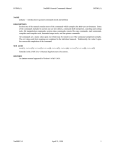
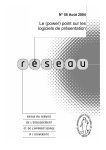


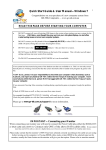

![Instalar y actualizar NetBSD-current [e] - Redes](http://vs1.manualzilla.com/store/data/006226705_1-100e74543fa3bea9f822ce307be8d1b9-150x150.png)
